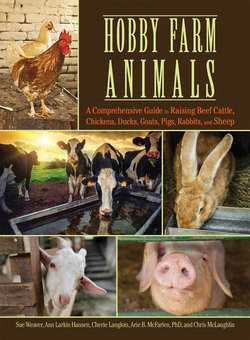Читать книгу Hobby Farm Animals - Chris McLaughlin - Страница 29
На сайте Литреса книга снята с продажи.
Calving
ОглавлениеA clean, green pasture in the spring is a great place for cows to calve. If you’re calving in cold or very wet weather, however, you should have a shed or a large pen with a thick layer of clean bedding (straw or old hay) available for the cows. Wherever you calve, plan on checking the cows and heifers several times a day to make sure no one is in trouble. Have a small pen ready for any cow that starts having problems.
As it gets close to calving time, watch the cows’ udders closely. Most, but not all, cows will “bag up” before calving. The udder will slowly swell and fill out over a few weeks. Then, a day or so before the calf arrives, the udder will start looking like a balloon that’s been blown up to the very edge of popping, and the teats will stick straight out. This is only a general rule, however. Some cows bag up days before the calf arrives, and some don’t bag up until the calf is on the ground.
When a cow is ready to calve, bagged up or not, she’ll wander off alone, provided there is sufficient room in the pasture and she can find a quiet corner. The cow will be restless and will graze just a few bites at a time or quit eating altogether. Some fluid may trickle down her legs, and she may keep her tail cocked. After a while, the cow may stand still and strain for a minute or so. Sooner or later, she will lie down and get serious. After some pushing, two little hooves will appear. After some more pushing, the nose will peek out. It usually takes a pretty good heave to get the head out; then the rest of the calf will follow in a rush. Immediately after the birth or up to twelve hours later, the placenta is delivered, and the cow usually eats it.
Within minutes of delivery, the cow should be up and licking the calf dry. Within an hour or two, at the most, the calf should be on its feet and looking for the teat. Seeing a calf born, get on its feet, and find milk is an amazing experience.
When to Intervene
For the beginning cattle producer, the number-one rule is not to intervene during calving unless it’s apparent that something is wrong. If a cow’s “water” (the fluid-filled membrane surrounding the calf) breaks—you’ll see a lot of yellowish fluid—and she hasn’t lain down and started hard labor within two to three hours, something is wrong. If a cow has been lying down and straining but fails to deliver a calf within an hour, something is wrong. If you see hooves appear and the entire calf doesn’t follow within an hour, something is wrong.
If, however, the cow is taking longer than expected but is on her feet and puttering around, not in any distress, with no sign of broken water but taking longer than you expected, chances are that nothing is wrong, and you should just leave her alone. Going out and bothering the cow will only upset her, slowing down the process even more.
Until you’ve had some experience with difficult calvings, it’s wise to call the veterinarian or an experienced neighbor before attempting to help the cow. Be prepared to give a precise description of the cow’s behavior and what you can observe at her back end. If the veterinarian can’t come immediately, get some advice about what to do.
If a cow is having a problem but still on her feet, herd her gently and slowly into a pen or chute, where you’ll be able to get close enough to give her a hand. If the cow is lying down, approach slowly, talking softly, and try to determine whether the calf is coming out the wrong way or whether the calf is too big for the cow.
A baby that is simply too big for its mama can sometimes be pulled out. Make a loop with a slipknot at the end of two flexible ropes, then slip a loop over each of the calf’s feet, just above the first joint of the leg. When the cow begins to strain, start to pull—hard enough to help but not so hard that you risk injuring the calf. When the cow quits straining, quit pulling until she starts again.
If that doesn’t bring the calf into the world, get help. If the calf is coming out the wrong way, get help. If the veterinarian can’t come, call a neighbor who has some experience. You may end up using a calf puller or, worse, having to kill the calf to save the cow. These are sad situations, and it’s why cattle owners pay a lot of attention to getting cows and heifers that calve easily.
If your cows calve out on pasture instead of in a small, closely monitored calving pen, you may not see a cow having its calf, even if you’re checking several times a day. As I said earlier, most of them will sneak off to a sheltered corner, often during the night, and in the morning when you check the cattle, you’ll find a mother with a dry, nursing, happy calf. If mother and baby are fine, leave them alone and let them rejoin the herd on their own schedule.
Nursing usually takes place naturally.
